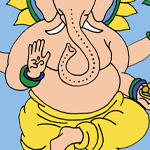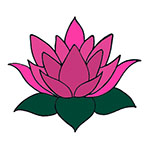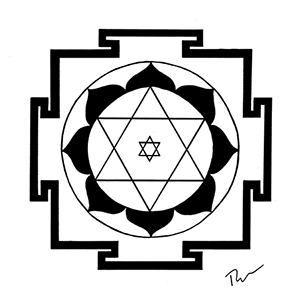
Ganesha Yantra Power and Meaning
Yantras are ancient geometric symbols that represent deities and forces or vibrations of God in a concrete way. This araticle covers the power and meaning of the various symbolic aspects of the Ganesha yantra. The Ganesha yantra utilizes many of the same basic shapes as the well-known Sri Yantra. The six-pointed star in the center of the yantra is a simplified version of the nine interlocking triangles of the Sri Yantra, symbolizing balance and harmony. Learn more about the Sri Yantra.
Use of Yantras
In general, yantras are mystical diagrams associated with particular thoughts and rituals. Yantras can be combined with mantras to accompany chanting and meditation. In some schools of thinking, the yantra is an actual dwelling place for a deity. A yantra can also store energy to provide protection to a person or geographical location.
Role of Ganesha
Ganesha is specifically associated with the earth element and with wealth. As a deity, he is credited with the ability to help launch new projects and to overcome obstacles that would prevent their success. Ganesha (also known as Ganesh or Ganapati) is a colorful and beloved aspect of Hinduism.

Gates Into the Ganesha Yantra
Let’s begin with the Ganesha yantra from the outer edges and move towards the center. On each side of the yantra are gates that open up to invite the viewer into the center of the yantra. There are four doorways or gates protruding from the square at the circumference of the Ganesha yantra.
Yantras and the Inner & Outer Worlds
These gates are thresholds between the inner and outer worlds. In this way, yantras can be viewed as a map of the spiritual journey from the outer to the inner along designated circuits. The gates also represent the four cardinal directions of north, south, east and west.
Using the Ganesha Yantra for Meditation
The Ganesha yantra is literally a gateway to accessing the inner of other dimensions. Meditating on the Ganesha yantra can help to discipline and train the mind. Holding the yantra firmly in mind improves the powers of visualization. This use of the third eye develops the powerful tool of spiritual vision.
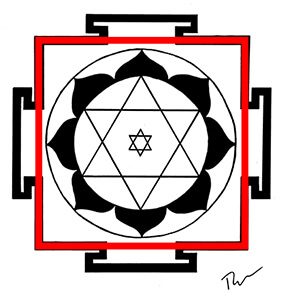
Square Meaning in the Ganesha Yantra
The outer square of the Ganesha yantra representing stability. This creates a solid foundation for the yantra. The square is a symbol of condensation and manifestation in the world. The square also creates a boundary around the inner world. Both the square and Ganesha himself are connected to the earth element in the Vedic five element system (earth, water, air, fire and ether).
Ganesha and the Root Chakra
Most yantras have a square as their fundamental form. The numerical equivalent, of course, is four. The square is also the base for the root chakra symbol. This makes perfect sense as Ganesha is a primary deity associated with the root chakra. The physical heaviness of an elephant helps to anchor this fundamental energy. Learn more in Chakra Symbols.

Circle Symbolism in the Ganesha Yantra
The circle is a physical manifestation that is a counterpart to the spiritual realms. A circle is a primordial form that cannot be further reduced. The circle symbolizes infinite space (the element akasha) and expansiveness. The circle also represents the cycles of nature at all levels from the atom to astronomy. The central quest of spirituality is to experience the oneness of these realms.
Circle Meaning and the Cosmos
The Hindu vision of the universe is a set of concentric circles. A metaphorical spider sits in the center, both spinning and reabsorbing the threads of reality. The circle represents the one force that both creates and unifies all things. The circle contains the notion that there is no end and no beginning to time. Accordingly, the numeric equivalent of the circle is zero.
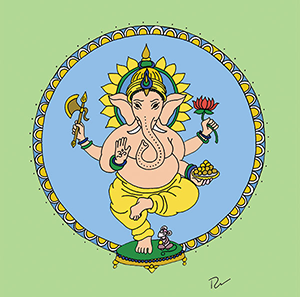
Lotus Symbolism in the Ganesha Yantra
The lotus symbolizes purity, enlightenment and transcendence. In a yantra, the lotus is usually viewed from the top, with the petals extending out on the rim of a circle. The lotus illustrates the unfolding of the divine essence within.
Ganesha Yantra and the Solar Plexus
The eight petals of the lotus in the Ganesha yantra are connected to the Manipura or solar plexus chakra. This chakra is located at the level of the belly or navel and also features eight petals. Learn more about the Solar Plexus Chakra Symbol.
Ganesha’s Belly and Abundance
Ganesha’s large stomach indicates that he contains all of the universes (cosmic eggs) of the past, present, and future. Ganesha’s belly also represents the ability to digest all experiences in life. Finally, the large belly of Ganesh symbolizes prosperity and abundance. This includes an abundance of food and all material possessions.
Lotus Flower in Hinduism
Likewise, the lotus is like the navel of creation. In fact, the lotus is sometimes depicted as springing from the navel of Vishnu and giving birth to Brahma, two of the gods in the Hindu trinity. The lotus is equated with beauty, prosperity and the eternal.
Lotus Meaning and the Heart
Furthermore, the lotus is a symbol of the heart, especially the inner or secret chamber of the heart. This is sometimes called Brahma’s cave or the city of Brahma in the East or the inner castle in the West. This is the core of being that remains untouched by everyday living.
Lotus Petals in the Ganesha Yantra
The Ganesha yantra features a single ring of lotus petals. The lotus petals represent creation and life force. Each petal has its own siddhi or power. Let’s take a look at the meaning of each lotus petal in the Ganesha yantra.
Circle of Lotus Petals
As mentioned above, the lotus petals in the Ganesha yantra represent siddhis or yogic powers. In addition to Ganesha, specific deities embody each of these powers. These are sometimes viewed as specific human activities: speech, motion, grasping, revulsion, enjoyment, attraction, equanimity and excretion.
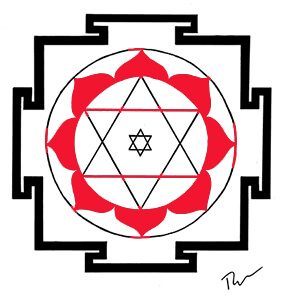
Meaning of Each Lotus Petal
Mastering the qualities of each petal through meditation, self-observation and individual effort can grant both worldly and spiritual success. The specific meaning of the petals can be outlined as follows:
ANIMA: This word means smallness or vulnerability. The siddhi or power conveyed is closely related to honesty with yourself and others. This is the ability to connect to yourself internally.
LAGHIMA: Laghima means bigness in the sense of taking the maximum amount of responsibility in your own life. This also conveys a connection to the largest self or the universe.
GARIMA: Garmina means heaviness, grounding, an anchor or a weight. This is a positive sense of being rooted to the earth, being unmoved by circumstances and sticking to your purpose.
MAHIMA: Mahima means creativity. This yogic power is a direct connection to a free flow of ideas and the resulting accomplishments.
EASATVA: Easatva means godliness and purity. This is the power of courage and confidence that comes from knowing you are pursuing your own highest calling in wisdom and love.
VASATVA: Vasatva means subjugation, bringing under control and conquering the self. This is the ability to overcome obstacles in life versus utilizing violence or overcoming others.
PRAAKAMYA: Praakamya means fulfilling the objective. This involves creating a strategy and a sense of conviction so strong that you feel that all that is necessary has already happened.
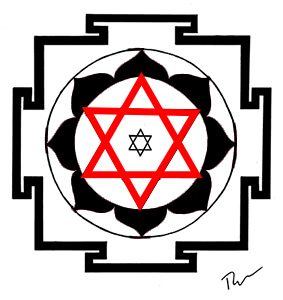
Triangle Symbolism in the Ganesha Yantra
The downward triangle is a symbol of the divine feminine and a depiction of the water element. An upward triangle represents the masculine energy and the element of fire. Numerous triangles can be interlocked in the center of a yantra.
Two Triangles of the Ganesha Yantra
In the case of the Ganesha yantra, there is a single upward triangle and a single downward triangle. Each of these triangle represents different planes of existence. The most basic meaning of the interlocking triangles is the union of the divine masculine and feminine. The upward triangle meets the downward triangle to form a six-pointed star.
Forces Represented by Triangles
Each triangle contains within itself three points. These represent the three basic forces in the universe: creation (sattva), preservation (rajas) and dissolution (tamas). These points and processes relate to the Hindu Trinity of Brahma, Vishnu and Shiva.
The Power of the Triangle
The Divine Mother (Shakti) is the force behind each of these that enlivens them and gives them power. The triangle is the primary form that can enclose space within straight lines. Thus the triangle is the first form to emerge from chaos and create order or structure.
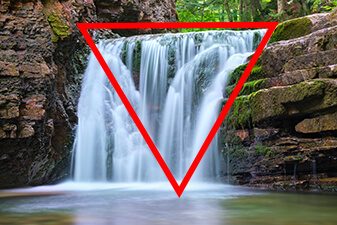
Downward Triangle in the Ganesha Yantra
A downward triangle is a symbol of the divine feminine. Downward triangles are connected to the water element. The easiest way to remember this is to think of a waterfall. In addition, water is related to the emotions. The word “emotion” can be interpreted as “energy in motion.”
Triangles and the Divine Feminine
Like water, feminine energy is free flowing and powerful. This energy is referred to as “shakti.” Downward triangles are specifically related to the Hindu goddesses Kali (Goddess of Time and Death), Parvati (Goddess of Fertility), Lalita (Goddess of Beauty), and Lakshmi (Goddess of Wealth).

Upward Triangle in the Ganesha Yantra
An upward triangle represents masculine energy and the element of fire. This shape can be seen in form of a campfire. In the Hindu tradition, an upward triangle is particularly associated with Shiva. The masculine force provides a counterpart and a container for the free flowing feminine energy.
Meaning of Interlocking Triangles
When numerous triangles are interlocked in the center of a yantra, each triangle represents a different plane of existence. The upward and downward triangles are symbolic of the repeating cycle of spirit into matter and matter into spirit. In the Ganesha yantra, the energy is cycling quickly from spirit into matter and back again.
Watch nearly 400 videos on the Vocal Medicine Channel!
Ganesha Seed Syllable Mantra
The mantra associated with this symbol is “Om Gam Ganapataye Namaha” and means “Salutations to the remover of obstacles!” Ganesha is the master of both inner and outer journeys. Ganesha is known for knowledge, patience, preparation and grounding. To learn more about yantras, see Yantra Meaning.
Author Kathleen Karlsen
Kathleen Karlsen is a musician, artist, writer and speaker. She is the author of two books (Flower Symbols and Vocal Medicine) and over 200 articles. Kathleen, her husband Andrew, and their five children live in Bozeman, Montana. More about Kathleen Karlsen.
GANESHA YANTRA ARTICLE SUMMARY
The Ganesha Yantra utilizes many of the same basic shapes as the well-known Sri Yantra. The six-pointed star in the center of the yantra is a simplified version of the nine interlocking triangles of the Sri Yantra, symbolizing balance and harmony. Learn about the meaning of the gates, square, circle, lotus petals and interlocking triangles in the Ganesha yantra.

